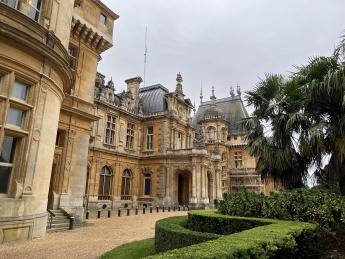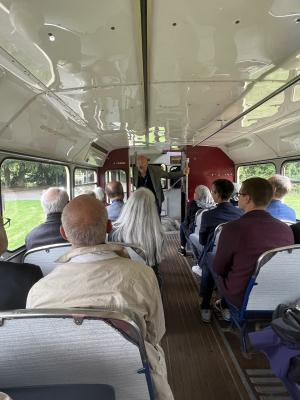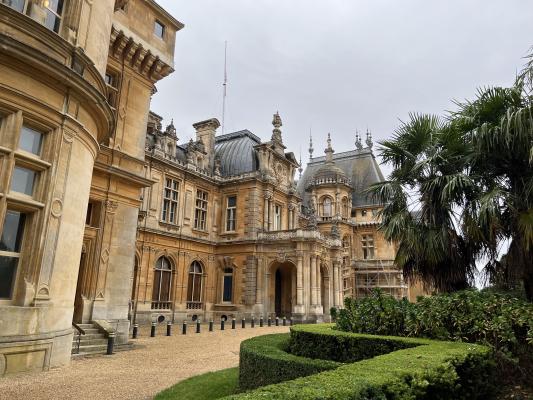News & Updates
ILAB's final Congress day: Waddesdon, Wormsley and some cèilidh dancing

Text by Anna Middleton, Images Angelika Elstner
(Please note, no photography was allowed at either Wormsley or Waddesdon)
Waddeson, a bucolic Oxfordshire manor, is home to one of the world's most extensive collections of trade cards and advertisements, purchased by Ferdinand in 1891 at one of the sales that dispersed the collections of Hippolyte Destailleur. The trade cards (and bills, invitations, etc.) were pasted down in a folio, with the pages containing booksellers' and binders' cards considerately marked for our perusal. In line with Ferdinand's taste, many of the books were brilliant examples of 18th century French bindings. Particularly stunning were the bindings for Bandello's La Prima Parte de le Novelle (1740) by Le Monnier, Baron Edmond de Rothschild's collection of illuminated manuscripts, including the Coronation of Anne of Brittany (c.1504), and Childe Harold's Pilgrimage (1812) inscribed by Byron to his half-sister, Augusta.
Wormsley is the private library of Paul Getty, and is quite simply one of the finest private collections of books and manuscripts in the world. The collection spans the 7th to the late 20th centuries, and is housed in a purpose-built library in the extensive grounds. It was an overwhelming experience. Every flat surface was densely arranged with the best books that money can buy. Shakespeare folios: first, second, third, and fourth. A whole table of elaborate 17th century bindings faced 20th-century masterpieces by Paul Bonet and Pierre-Lucien Martin, with yet another table full of immaculate Doves Bindery work between them. There were multiple early English bestiaries in manuscript on vellum, including a previously unrecorded example (c. 1275), which is one of the most extensively illustrated known. Many items (Anne Boleyn's Psalter; Caxton's Canterbury Tales ... ) barely required a label. A room upstairs was dedicated to binding practices and texts relating to them, including original artwork, an apprentice Indenture from 1809, and what might be the earliest surviving British binder's ticket: John Brotherton's, inside the front cover of Beveridge's Private Thoughts upon a Christian Life (1713).
Downstairs, I almost missed Eusebius Pamphili's Historia ecclesiastica (c.640-50?), the second oldest manuscript of the text, and "possibly the earliest surviving English manuscript, perhaps read by the Venerable Bede himself", because it was underneath a Limoges enamel book (c. 1200) that looked like it had been made yesterday. Some tables barely needed to be lit: the 20th century examples of fine press and illumination could be seen from the gallery. There were calligraphic manuscripts of Keats's Endymion, Coleridge's Kubla Khan, and Sheila Water's extraordinary illumination of Dylan Thomas's Under Milk Wood. Some of the vellum was so fresh it looked wet, and the blue of the hand-coloured Cosmographia actually shimmered in the light.
The grounds at Wormsley are breathtaking in their own right, but against the sheer density of the library, the Garsington Opera and the two-acre Walled Garden were a relief. The groups who saw the library first had the garden as a palliative oasis, while those who saw the grounds first had to recover on the bus back. Most had managed it by the evening, where ILAB's Oxford Congress was brought to a close in traditional fashion: a cèilidh at a riverside pub.
The Congress was, by all reports, an overwhelming success and a monumental feat of planning and execution. It was four days of fine books and fine people, and a real testament to the international character of the trade. It was a privilege to attend, and my thanks go out to the many brilliant organisers, who managed to get booksellers into boats and, most impressively, onto the dance floor.






















